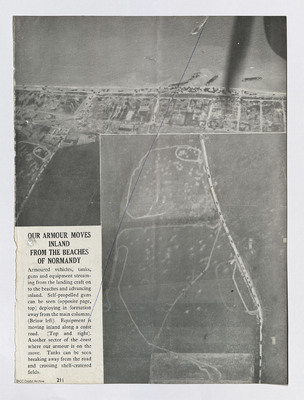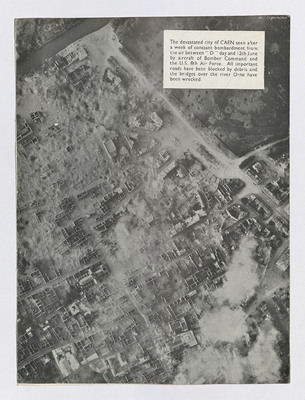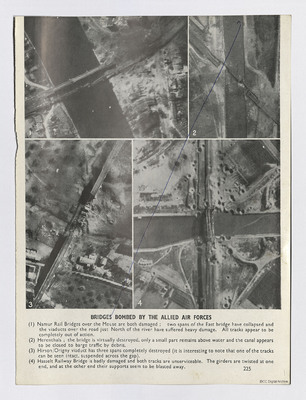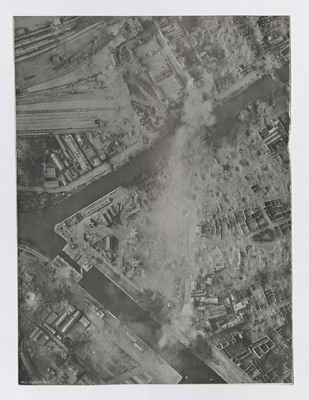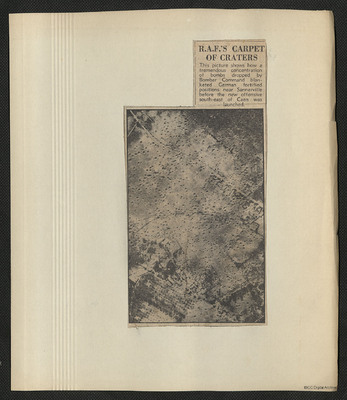Air to ground photographs after D Day
Title
Air to ground photographs after D Day
Description
Five newspaper clippings, four with captions, illustrate the damage done to the infrastructure in support of the allied ground forces.
The first captioned 'Our armour moves inland from the beaches of Normandy'. This shows part of the beach with landing craft and vehicles. It also shows roads parallel to the beach and roads going inland with many vehicles using them.
The second shows part of Caen after the post D Day bombing. It shows the utter devastation of the city after these raids.
The third captioned 'Bridges bombed by the Allied Air Forces' shows road and rail bridges away from the immediate area of the D Day landings. The first photograph shows two railway bridges over the Meuse at Namur both heavily damaged. The second shows a bridge over a canal at Herenthals completely destroyed. The third photograph is a railway viaduct at Hirson/Origny with three spans destroyed. The fourth is the railway bridge at Hasselt which is badly damage and adjacent infrastructure destroyed.
The fourth clipping has no descriptive text, but is a low level photograph of a small part of a port town showing a river junction, roofless buildings, bomb craters, a dock basin and a number of bridges.
The fifth shows the cratering in open country created in support of ground operations around Caen.
The first captioned 'Our armour moves inland from the beaches of Normandy'. This shows part of the beach with landing craft and vehicles. It also shows roads parallel to the beach and roads going inland with many vehicles using them.
The second shows part of Caen after the post D Day bombing. It shows the utter devastation of the city after these raids.
The third captioned 'Bridges bombed by the Allied Air Forces' shows road and rail bridges away from the immediate area of the D Day landings. The first photograph shows two railway bridges over the Meuse at Namur both heavily damaged. The second shows a bridge over a canal at Herenthals completely destroyed. The third photograph is a railway viaduct at Hirson/Origny with three spans destroyed. The fourth is the railway bridge at Hasselt which is badly damage and adjacent infrastructure destroyed.
The fourth clipping has no descriptive text, but is a low level photograph of a small part of a port town showing a river junction, roofless buildings, bomb craters, a dock basin and a number of bridges.
The fifth shows the cratering in open country created in support of ground operations around Caen.
Temporal Coverage
Language
Type
Format
Five newspaper clippings
Conforms To
Publisher
Rights
This content is available under a CC BY-NC 4.0 International license (Creative Commons Attribution-NonCommercial 4.0). It has been published ‘as is’ and may contain inaccuracies or culturally inappropriate references that do not necessarily reflect the official policy or position of the University of Lincoln or the International Bomber Command Centre. For more information, visit https://creativecommons.org/licenses/by-nc/4.0/ and https://ibccdigitalarchive.lincoln.ac.uk/omeka/legal.
Contributor
Identifier
SKingEJ182986v10128, SKingEJ182986v10129, SKingEJ182986v10131, SKingEJ182986v10132, SKingEJ182986v10133
Transcription
[Photograph]
OUR ARMOUR MOVES INLAND FROM THE BEACHES OF NORMANDY
Armoured vehicles, tanks guns and equipment streaming from the land craft on to the beaches and advancing inland. Self-propelled guns can be seen (opposite page, top) deploying in formation away from the main columns (Below left). Equipment is moving inland along a coast road. (Top and right) Another sector of the coast where our armour is on the move. Tanks can be seen breaking away from the road and crossing shell – cratered fields
[inserted]211[/inserted]
[Page Break]
[photograph]
The devastated city of CAEN seen after a week of constant bombardment from the air between “D” day and the 12th June by aircraft of Bomber Command and the U.S. 8th Air Force. All important roads have been blocked by debris and the bridged over the river Orne have been wrecked.
[Page Break]
[photographs]
BRIDGES BOMBED BY THE ALLIED AIR FORCES
(1) Namur Rail Bridged over the Meuse are both damaged; two spans of the East bridge have collapsed and the viaducts over the road just North of the river have suffered heavy damage. All tracks appear to be completely out of action.
(2) Herenthals; the bridge is virtually destroyed, only a small part remains above the water and the canal appears to be closed to the barge traffic by debris.
(3) Hirson/Origny viaducts has three spans completely destroyed (it is interesting to note that one of the tracks can be seen intact, suspended across the gap).
(4) Hasselt Railway Bridge is badly damaged and both tracks are unserviceable. The girders are twisted at one end, and at the other end their supports seems to be blasted away.
225
[Page Break]
[Photograph]
[Page Break]
R.A.F.’S CARPET OF CRATERS
This picture shows how a tremendous concentration of bombs dropped by Bomber Command blanketed German fortified positions near Sannerville before the new offensive south-east of Caen was launched.
OUR ARMOUR MOVES INLAND FROM THE BEACHES OF NORMANDY
Armoured vehicles, tanks guns and equipment streaming from the land craft on to the beaches and advancing inland. Self-propelled guns can be seen (opposite page, top) deploying in formation away from the main columns (Below left). Equipment is moving inland along a coast road. (Top and right) Another sector of the coast where our armour is on the move. Tanks can be seen breaking away from the road and crossing shell – cratered fields
[inserted]211[/inserted]
[Page Break]
[photograph]
The devastated city of CAEN seen after a week of constant bombardment from the air between “D” day and the 12th June by aircraft of Bomber Command and the U.S. 8th Air Force. All important roads have been blocked by debris and the bridged over the river Orne have been wrecked.
[Page Break]
[photographs]
BRIDGES BOMBED BY THE ALLIED AIR FORCES
(1) Namur Rail Bridged over the Meuse are both damaged; two spans of the East bridge have collapsed and the viaducts over the road just North of the river have suffered heavy damage. All tracks appear to be completely out of action.
(2) Herenthals; the bridge is virtually destroyed, only a small part remains above the water and the canal appears to be closed to the barge traffic by debris.
(3) Hirson/Origny viaducts has three spans completely destroyed (it is interesting to note that one of the tracks can be seen intact, suspended across the gap).
(4) Hasselt Railway Bridge is badly damaged and both tracks are unserviceable. The girders are twisted at one end, and at the other end their supports seems to be blasted away.
225
[Page Break]
[Photograph]
[Page Break]
R.A.F.’S CARPET OF CRATERS
This picture shows how a tremendous concentration of bombs dropped by Bomber Command blanketed German fortified positions near Sannerville before the new offensive south-east of Caen was launched.
Collection
Citation
“Air to ground photographs after D Day,” IBCC Digital Archive, accessed October 29, 2024, https://ibccdigitalarchive.lincoln.ac.uk/omeka/collections/document/34227.
Item Relations
This item has no relations.

